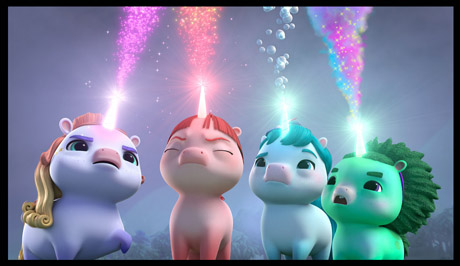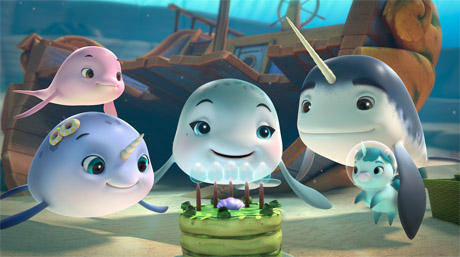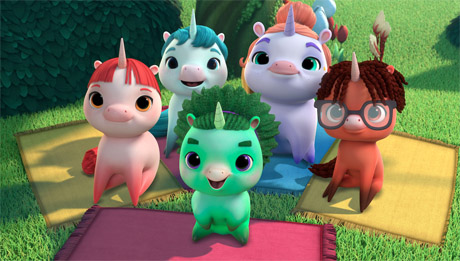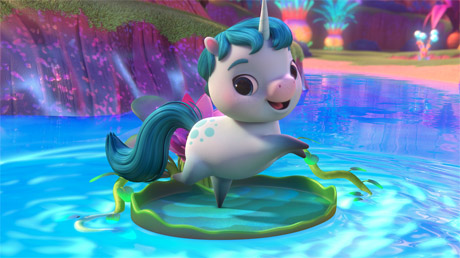
New DreamWorks Animation family series Not Quite Narwhal is now streaming on Netflix. It’s based on a popular book about a narwhal named Kelp who finds out he’s actually a unicorn. Kelp decides to spend time on both land and sea, and the show shines in spotlighting who you are and how your friends and family bring out the best in you. Co-Executive Producers Brian K. Roberts, Nakia Trower Shuman and Sarah Katin join me for this Animation Scoop Interview, which was conducted as an Email Q&A.
Jackson Murphy: What aspects of Jessie Sima’s book did you fall in love with and want to adapt for the screen?
Nakia Trower Shuman: That’s what is so wonderful about the book. There’s not one single thing that is great over another, it is just awesome in its entirety. It is fun, charming and has a beautiful theme. It was super important to us that we kept true to the book as much as possible and that none of its brilliance was lost in translation to the screen.

Sarah Katin: So many things really. I fell in love with Kelp at first sight. An adorable little unicorn living in the sea with a community of narwhals. How could you not? And then it was such a sweet, thoughtful story with a beautiful message about accepting differences and being true to yourself. I knew this was a theme we could carry through a whole series. Along with that, Jessie (Sima) created such a whimsical fun world to play in. They painted a land where unicorns strum guitars and peddle snow cones. It just seemed like a world we could have a lot of fun expanding on but inspired by the spirit of the book.
Brian K. Roberts: I loved the visual humor that Jessie Sima brought to the illustrations. Many of their little visual gags found their way into the series, such as Kelp trying to learn how to walk by copying a turtle and unicorns making each other into sand-narwhals on the beach.
JM: Much like the first episode, storytelling is all about exploration. What did you truly want to explore through your work on this series?
NTS: Being so inspired by the book we just wanted to know more. Things like, How does Kelp balance his two worlds? How does he navigate learning all things “narwhal”? What kinds of fun and adventures will he get up to with both his underwater and above land friends? Figuring out the answers combined with looking at things from the unique points of view/personalities of our characters gave us so much we could really dive into.
SK: We like to call Not Quite Narwhal (the series) a social-emotional adventure/comedy. We wanted to explore a fun, active, and imaginative world of unicorns as well as highlight the true spirit and magic that exists under the sea. We also wanted to explore the themes Jessie (Sima) introduced in their book. The book only focuses on Kelp. But, getting to do an entire series meant we could explore new and interesting characters who are all different and unique in their own special ways.

JM: Kelp is a sincere, special main character. How is Kelp ‘not quite’ like any other main character on children’s television right now?
NTS: – He’s just got such a unique point of view, he’s a unicorn who grew up as a narwhal and he fully embraces that fact. He’s Kelp and there’s only one Kelp.
SK: I like to think what makes Kelp stand out from the pack is that he’s like a real kid. Meaning he makes mistakes and has big feelings that he might not entirely understand, just like the kids who will be watching our show.
JM: The voices of the lead characters are so sweet and you can tell they provide such happiness. What were your goals with the voice performances?
NTS: It was super important that our voices felt unique and natural and my gosh our actors are our dream cast really! Over the course of the season, led by our extraordinary voice director Mary Elizabeth McGlynn, it was just remarkable to watch our actors in action and fully make our characters their own.

SK: Just like we strove to make Kelp feel like a real kid, we wanted the voices to sound like real kids too. We wrote lines for them, but some of our actors were as young as five and couldn’t even really read yet. So if they didn’t say the lines perfectly, that was okay. It felt authentic.
JM: How did you want to balance Kelp’s time/adventures in the two, key locations (land and sea)?
NTS: We felt that both worlds were equally important to Kelp and therefore we tried to balance our stories between the two as much as possible.
SK: The ending of the book really set us up for a series. Kelp discovered he was a unicorn and realized he didn’t have to choose between his two worlds – he could embrace both sides of himself. Therefore, it was really important to us that we had an equal balance of his two worlds. Initially, we thought it was going to be a challenge. We figured we’d want to spend a lot of time in the imaginative unicorn realm. But then we discovered how truly magical our ocean is. One of our writers was even an oceanographer and taught us some amazing things that made our ocean seem as fantastical as a land full of rainbow-sparking unicorns.
JM: Kelp’s parents are very supportive and understanding. Was their excellent dialogue (especially at the end of the first episode) some of the most challenging lines to write/present?
NTS: We knew how important that beat was in the story from early on, so we knew what we needed those lines to say. Then knowing our characters to be very loving and nurturing but also not perfect, we just sort of massaged the lines until they felt and sounded like them.
SK: Yes. We knew we had to get that right. Luckily, we had an excellent child psychologist who consulted with us on the dialogue.
JM: Why do you think so many children love/respond to unicorns?
NTS: Because they are just so unbelievably rad. (laughs) This is just a guess but there’s something so cool about taking a horse which is already a beautiful creature and giving it magical qualities and features. It allows a kid to switch on their imaginations and play around which is also very cool.
SK: You’re talking to a horse girl. Then you throw a magical horn on said horse. Well, that’s just the dream, isn’t it?
BKR: Unicorns are definitely perpetually popular, but what’s even more interesting is the sudden interest in narwhals over the last few years. Narwhals are everywhere these days! We had several people working on the show who didn’t know that narwhals were real!

JM: I remember my introduction to snow-cones in elementary school. Do you remember yours?
NTS: I don’t think it was until I moved to America that I had my first snow cone. It was at the Studio City markets and it was super sweet! I do remember in primary school in Australia, we had “frozen cups” which was basically a cup of frozen juice or cordial that you needed to pop out and flip upside down so you could lick it. I’m not sure that it counts though.
SK: I don’t remember my first ever snow-cone, but I do remember that I wanted it to be the rainbow-colored one.
BKR: Unfortunately I do. It was at a YMCA pool party and I HATED it. I still hate sno-cones to this day, all crunchy gross ice and watered down kool aid pooling in the bottom of the drippy paper cone. Give me a New Orleans style sno-ball or a Hawaiian shave ice, though, and I’ll be your friend forever.
JM: When did you find your ‘spark’ in life?
NTS: I don’t know if I can boil it down to a single event. I think it’s probably more of a series of events that has created my spark – but mostly I’d say it’s the spesh people I’m lucky to have in my life who always encourage my spark to sparkle.
SK: The joy of ‘spark’ is that there isn’t just one. You can have many ‘sparks’ in life. Definitely traveling and meeting my writing partner/bestie (Nakia) was a ‘sparkful’ moment. But also discovering my love of storytelling was full of ‘spark’. Now, I look forward to whatever ‘sparks’ the future holds.
BKR: When I was little I liked being on stage, acting and singing. In high school I went through a shy stage where I didn’t want to be on stage and started doing visual art instead. One day in 10th grade I realized that I could combine my loves of storytelling, music, and art into the amazing magic of animation. That realization continues to fill every day with spark for me.
JM: What do you hope viewers take away from the show’s central themes of friendship, acceptance, knowing who you are and how you can impact others?
NTS: Our hope is that our viewers can connect with our characters and feel like they could be friends with them too. Perhaps they identify with our characters in some way and feel inspired and encouraged to really embrace who they are.
SK: Nakia and I never want to feel “preachy”. So, in the end, if kids find great joy in Kelp and his adventures below and above the water, then we’re happy. But if they also pick up on some of the themes of friendship, acceptance, and knowing who you are and how you can impact others, well, that’s just gravy. It’s like our superstar development exec, Vanessa Taylor Sands, who championed this project from the start said: It’s Zumba. You’re having so much fun you might not even realize you’re getting exercise too.
BKR: Much of what’s wrong in the world could be helped with more empathy- the ability to see things from each other’s perspectives. I hope the show helps kids understand themselves better and also understand each other better.
- INTERVIEW: Strap In For “Mars Express” - April 30, 2024
- INTERVIEW: Jeff Fowler On “Knuckles” And “Sonic 3” - April 22, 2024
- INTERVIEW: “Inside Out 2” Director And Producer On Pixar Sequel - April 16, 2024


 June 22nd, 2023
June 22nd, 2023  Jackson Murphy
Jackson Murphy  Posted in
Posted in  Tags:
Tags: 






